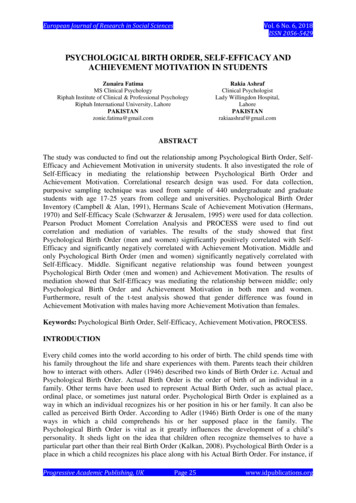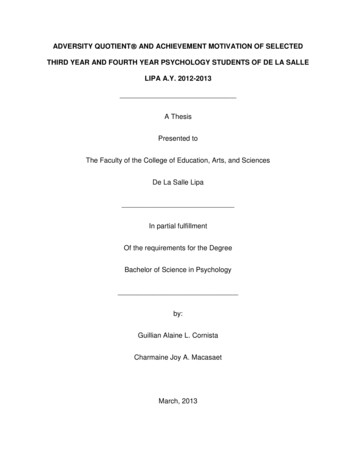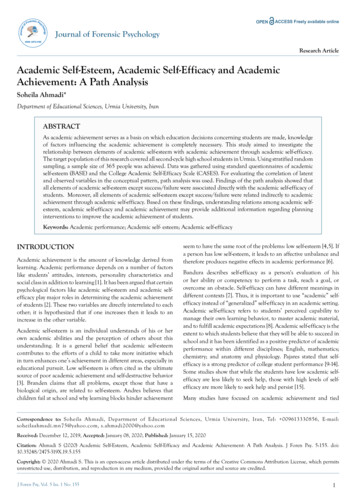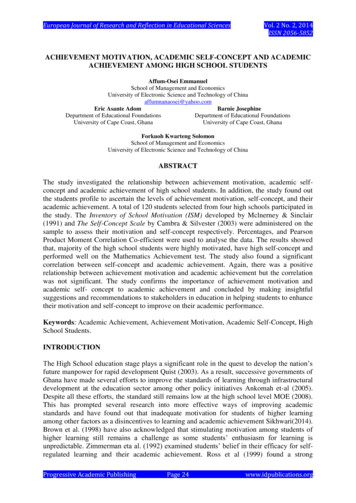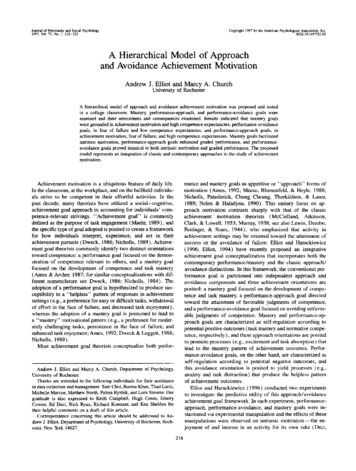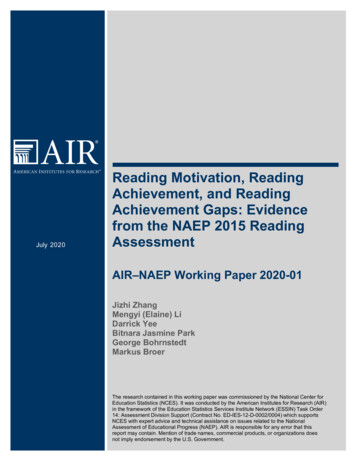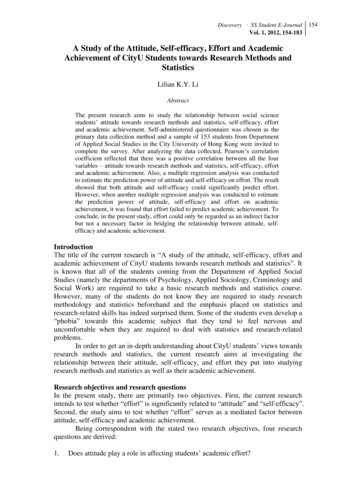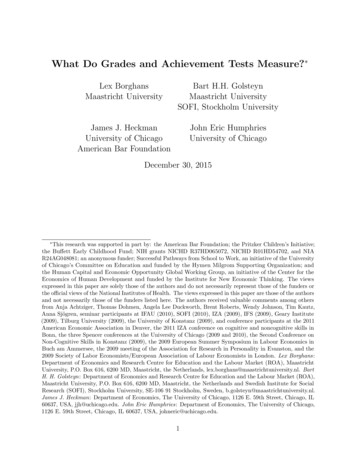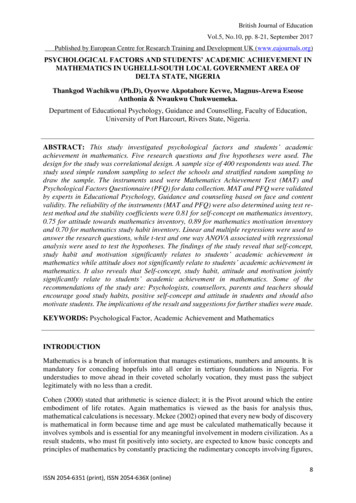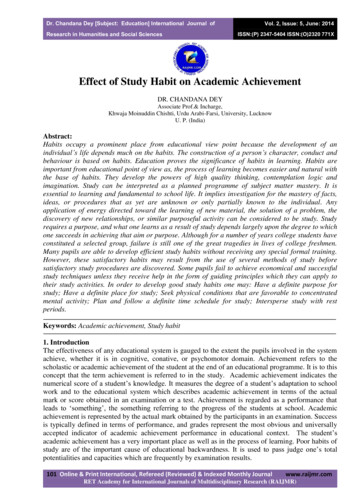
Transcription
Intrinsic Motivation and Academic AchievementWhat Does Their Relationship Imply for the Classroom Teacher?POONAMC.DEVA B S T R A C TL N C O U R A G I N G CHILDREN'S INTRINSICVATION CAN HELP T H E M TO ACHIEVE ACADEMIC(ADELMAN,1983,1978;A D E L M A N & TAYLOR, 1986;1 9 8 5 ) . TO H E L P STUDENTS WITH A N IED,WITHOUTTO DEVELOP ACADEMICINTRINSICIT IS IMPORTANT TO D E F I N E T H E FACTORS THATAFFECT MOTIVATION(ADELMAN & CHANEY,1982;ADELMAN& TAYLOR, 1983). T H I S ARTICLE OFFERS EDUCATORS ANINSIGHT INTO T H E EFFECTS OF D I F F E R E N IONALON T H E SCHOOL L E A R N I N G OF STUDENTS WITHAS W E L L AS INTO T H EVARIABLESI N T R I N S I C A N D EXTRINSIC MOTIVATION.ALSOINCLUDED ARE RECOMMENDATIONS, BASED ON E M P I R I C A LEVIDENCE,FOR E N H A N C I N G ACADEMICINTRINSICMOTIVATIONIN LEARNERS OF VARYING A B I L I T I E S AT A L L GRADEILEVELS.NTEREST IN THE VARIOUS ASPECTS OF INTRINSICand extrinsic motivation has accelerated in recent years.Motivational orientation is considered to be an importantfactor in determining the academic success of childrenwith and without disabilities (Adelman & Taylor, 1986;Calder & Staw, 1975; Deci, 1975; Deci & Chandler, 1986;Schunk, 1991). Academic intrinsic motivation has beenfound to be significantly correlated with academic achievement in students with learning disabilities (Gottfried, 1985)and without learning disabilities (Adelman, 1978; Adelman& Taylor, 1983). However, children with learning disabilil OR E M E D I A LANDS P E C I A LE D U C A T I O NVolume 18. Number 1, January/February 1997, Pages 12-19ties (LD) are less likely than their nondisabled peers to beintrinsically motivated (Adelman & Chaney, 1982; Adelman& Taylor, 1986; Mastropieri & Scruggs, 1994; Smith, 1994).Students with L D have been found to have more positiveattitudes toward school than toward school learning (Wilson & David, 1994). Wilson and David asked 89 studentswith L D to respond to items on the School Attitude Measures (SAM; Wick, 1990) and on the Children's AcademicIntrinsic Motivation Inventory ( C A I M I ; Gottfried, 1986).The students with L D were found to have a more positiveattitude toward the school environment than toward academic tasks. Research has also shown that students withL D may derive their self-perceptions from areas other thanschool, and do not see themselves as less competent inareas of school learning (Grolnick & Ryan, 1990).Although there is only a limited amount of researchavailable on intrinsic motivation in the population withspecial needs (Adelman, 1978; Adelman & Taylor, 1986;Grolnick & Ryan, 1990), there is an abundance of researchon the general school-age population. This article is anattempt to use existing research to identify variables pertinent to the academic intrinsic motivation of children withlearning disabilities. The first part of the article deals withthe definitions of intrinsic and extrinsic motivation. Thenext part identifies some of the factors affecting the motivational orientation and subsequent academic achievement of school-age children. This is followed by empiricalevidence of the effects of rewards on intrinsic motivation,and suggestions on enhancing intrinsic motivation in thelearner. At the end, several strategies are presented thatcould be used by the teacher to develop and encourageintrinsic motivation in children with and without LD.
DEFINING MOTIVATIONAL ATTRIBUTESIntrinsicMotivationIntrinsic motivation has been defined as (a) participation inan activity purely out of curiosity, that is, from a need toknow more about something (Deci, 1975; Gottfried, 1983;Woolfolk, 1990); (b) the desire to engage in an activitypurely for the sake of participating in and completing atask (Bates, 1979; Deci, Vallerand, Pelletier, & Ryan, 1991);and (c) the desire to contribute (Mills, 1991).Academic intrinsic motivation has been measured by(a) the ability of the learner to persist with the task assigned(Brophy, 1983; Gottfried, 1983); (b) the amount of timespent by the student on tackling the task (Brophy, 1983;Gottfried, 1983); (c) the innate curiosity to learn (Gottfried,1983); (d) the feeling of efficacy related to an activity(Gottfried, 1983; Schunk, 1991; Smith, 1994); (e) thedesire to select an activity (Brophy, 1983); and (f) a combination of all these variables (Deci, 1975; Deci & Ryan,1985). A student who is intrinsically motivated will persistwith the assigned task, even though it may be difficult(Gottfried, 1983; Schunk, 1990), and will not need anytype of reward or incentive to initiate or complete a task(Beck, 1978; Deci, 1975; Woolfolk, 1990). This type ofstudent is more likely to complete the chosen task and beexcited by the challenging nature of an activity. The intrinsically motivated student is also more likely to retain theconcepts learned and to feel confident about tacklingunfamiliar learning situations, like new vocabulary words.However, the amount of interest generated by the taskalso plays a role in the motivational orientation of the learner.An assigned task with zero interest value is less likely tomotivate the student t h a n is a task that arouses interestand curiosity. Intrinsic motivation is based in the innate,organismic needs for competence and self-determination(Deci & Ryan, 1985; Woolfolk, 1990), as well as the desireto seek and conquer challenges (Adelman & Taylor, 1990).People are likely to be motivated to complete a task on thebasis of their level of interest and the nature of the challenge. Research has suggested that children with higheracademic intrinsic motivation function more effectively inschool (Adelman & Taylor, 1990; Boggiano & Barrett,1992; Gottfried, 1990; Soto, 1988). Besides innate factors,there are several other variables that can affect intrinsicmotivation.ExtrinsicMotivationAdults often give the learner an incentive to participate inor to complete an activity. The incentive might be in theform of a tangible reward, such as money or candy. Or, itmight be the likelihood of a reward in the future, such as agood grade. Or, it might be a nontangible reward, forexample, verbal praise or a pat on the back. The incentivemight also be exemption from a less liked activity or avoid-ance of punishment. These incentives are extrinsic motivators. A person is said to be extrinsically motivated when sheor he undertakes a task purely for the sake of attaining areward or for avoiding some punishment (Adelman &Taylor, 1990; Ball, 1984; Beck, 1978; Deci, 1975; Wiersma,1992; Woolfolk, 1990).Extrinsic motivation can, especially in learning andother forms of creative work, interfere with intrinsic motivation (Benninga et al., 1991; Butler, 1989; Deci, 1975;McCullers, Fabes, & Moran, 1987). In such cases, it mightbe better not to offer rewards for participating in or forcompleting an activity, be it textbook learning or an organized play activity. N o t only teachers but also parentshave been found to negatively influence the motivationalorientation of the child by providing extrinsic consequencescontingent u p o n their school performance (Gottfried,Fleming, & Gottfried, 1994). The relationship betweenrewards (and other extrinsic factors) and the intrinsic motivation of the learner is outlined in the following sections.MOTIVATION AND THE LEARNERIn a classroom, the student is expected to tackle certaintypes of tasks, usually with very limited choices. Most ofthe research done on motivation has been done in settingswhere the learner had a wide choice of activities, or in afree-play setting. In reality, the student has to completetasks that are compulsory as well as evaluated (Brophy,1983). Children are expected to complete a certain number of assignments t h a t meet specified criteria. For example, a child may be asked t o complete five multiplicationproblems and is expected t o get correct answers to at leastthree. Teachers need to consider how instructional practices are designed from t h e motivational perspective(Schunk, 1990).Development of skills required for academic achievement can be influenced by instructional design. If thedesign undermines student ability and skill level, it canreduce motivation (Brophy, 1983; Schunk, 1990). This isespecially applicable to students with disabilities. Studentswith L D have shown a significant increase in academiclearning after engaging in interesting tasks like computergames designed to enhance learning (Adelman, Lauber,Nelson, & Smith, 1989). A c o m m o n aim of educators is tohelp all students enhance their learning, regardless of thestudent's ability level. To achieve this outcome, the teacherhas to develop a curriculum geared to the individual needsand ability levels of the students, especially the studentswith special needs. If the assigned task is within the child'sability level as well as inherently interesting, the child isvery likely to be intrinsically motivated to tackle the task.The task should also be challenging enough to stimulatethe child's desire to attain mastery.The probability of success or failure is often attributedto factors such as ability, effort, difficulty level of the task,R E M E D I A LANDS P E C I A LE D U C A T I O NVolume 18, Number 1, January/February 19971 O
and luck (Schunk, 1990). O n e or more of these attributesmight, in turn, affect the motivational orientation of astudent. The student who is sure of some level of success ismore likely to be motivated to tackle the task than one whois unsure of the outcome (Adelman & Taylor, 1990). Astudent who is motivated to learn will find school-relatedtasks meaningful (Brophy, 1983, 1987). Teachers can helpstudents to maximize their achievement by adjusting theinstructional design to their individual characteristics andmotivational orientation. The personality traits and motivational tendency of learners with mild handicaps caneither help them t o compensate for their inadequate learning abilities and enhance performance or retard their academic achievement by intensifying their learning deficits(Adelman, MacDonald, Nelson, Smith, & Taylor, 1990;Black, 1974; Grolnick & Ryan, 1990; Soto, 1988; Switzky& Schulz, 1988; Wilson & David, 1994).Students in one classroom may differ in their levels ofcognitive development. To develop a curriculum that willchallenge and motivate each learner, it is crucial to knowthe developmental level of the children (Gottfried, 1983).Piaget's theory of child development stipulates that children act on their environment, and vice versa, and that itis through this interaction that learning takes place. Anenvironment that promotes mastery motivation is one wherechildren are likely to perceive successful outcomes of theiractions (Gottfried, 1983; Weiner, 1979).ENHANCING INTRINSICMOTIVATION—RESEARCH BACKGROUNDA student's lack of achievement in school may be a resultof her or his expecting to perform poorly on an assignedtask or perceiving school personnel and activities as threatsto her or his self-determination, competence, or sense ofrelatedness (Adelman & Taylor, 1990). With this in mind,intervention should focus on strategies to replace threatening or intimidating situations and tasks. This could beachieved by (a) eliminating, or at least minimizing, external pressures (e.g., rewards); and (b) by developing anintrinsically motivating activity. Classroom climate andteacher interaction with students have been found to playa crucial role in influencing student achievement and motivation (Brophy, 1987; Cunniff, 1989; Grolnick & Ryan,1990).Options alone are not sufficient to enhance intrinsicmotivation (Woolfolk, 1990). Also necessary is a structurethat encourages and supports student involvement in thedecision-making process. Feedback on student progressmust include effectiveness of the decisions made by thestudent, in addition to evaluation of the task performance(Adelman & Taylor, 1990; Deci & Ryan, 1985). In somesettings, intervention strategies might need to focus onalternatives capable of stimulating greater feelings of selfdetermination, of competence, and of being related to1 AR E M E D I A LANDS P E C I A LE D U C A T I O NVolume 18, Number 1, January/February 1991others (Adelman & Taylor, 1990; Brophy, 1987). Someresearchers have found that the academic intrinsic motivation of students with L D can be increased with attributiontraining (Adelman & Chaney, 1982; Borkowski, Weyhing,& Carr, 1988; Rawson, 1993; Schunk & Cox, 1986; Shelton,Anastopoulos, & Linden, 1985). However, other researchhas shown no significant difference after attribution training (Fulk, Mastropieri, & Scruggs, 1992; Okolo, 1992).Motivational analyses of the problem to be tackledcan point to corrective steps for implementation by teachers, clinicians, parents, or the students themselves. Theintervention must deal with the initial attitudes these youngsters are likely to bring, and be able to enhance the youngsters' motivational readiness and maintain the youngsters'positive intrinsic motivation. A variety of empirically validated strategies to enhance intrinsic motivation in theclassroom are presented at the end of this article.REWARDS AND MOTIVATION—RESEARCH BACKGROUNDAlthough external rewards have been used in the classroom for more t h a n a century to bring about desiredbehavior, their efficacy is being questioned by educatorsand parents alike. Researchers have found that tangiblerewards and other extrinsic motivators can have detrimental effects on the intrinsic motivation of the learner (Beck,1978; Deci, 1975; Deci & Ryan, 1985; Greene & Lepper,1974; McCullers et al., 1987; Rummel & Feinberg, 1988;Zbrzezny, 1989). If a student is told that she or he will earna desired reward for participating in or successful completion of a task, that student is less likely t o tackle the sametask when no incentive is offered. (For more informationon the effects of rewards on intrinsic motivation, readmeta-analyses by C a m e r o n & Pierce, 1994; Rummel &Feinberg, 1988; and Wiersma, 1992.)Rewards or punishment used to control behavior areoften perceived by the learner as stressful (Deci & Ryan,1985). Self-determination can be limited if students perceive rewards as controls upon their task performance(Adelman & Taylor, 1990; Dollinger & Thelen, 1978;Harackiewicz, 1979; Zbrzezny, 1989). Intrinsic motivation prompts an individual to seek out challenges, to chooseto participate in a task, to feel competent, and to feel partof a community (Deci & Ryan, 1980; Deci et al., 1991;Gottfried, 1983; Woolfolk, 1990). Rewards contingent ontask performance or level of achievement can, therefore,affect the forces of intrinsic motivation negatively.In one study, students who were offered rewards notrelevant to their performance lost interest in the task evenwhen they had been successful during a previous attempt(Karniol & Ross, 1977). Some professionals suggest thateducators should consider employing reinforcers related toacademics or school activities, for example, choice of home-
work, grade points, field trips, more free time, and computer use (Reynolds, Salend, & Beahan, 1992).There are, however, researchers who have found theopposite to be true. For example, Kruglanski et al. (1975)found that tangible reinforcers associated with the taskenhanced intrinsic motivation, but those not associatedwith the task decreased intrinsic motivation in the learner.However, the effects of noncontingent rewards on theintrinsic motivation of the student are not clear (Calder &Staw, 1975; Karniol & Ross, 1977). In some cases, positivefeedback has been shown to enhance intrinsic motivation,independent of any other reward offered (Cameron &Pierce, 1994; Harackiewicz, 1979; Zbrzezny, 1989), or tohave no effect on subsequent intrinsic motivation of thesubject (Dollinger & Thelen, 1978).There is also a body of research that has yielded mixedresults. Rewards in the form of verbal praise were found toenhance the intrinsic motivation of boys but inhibit that ofgirls (Boggiano, Main, & Katz, 1991; Zinser, Young, &King, 1982). If the reward is unexpected, it usually doesnot have any effect on the intrinsic motivation of thelearner (Greene & Lepper, 1974; Lepper & Greene, 1975).In a study done on 24 preschool children, those whoinitially had high interest and received a reward had lostinterest when observed a week later, whereas the childrenwho initially had low interest who were rewarded gainedinterest (Loveland & Olley, 1979). In a study by Boggiano,Harackiewicz, Bassette, and Main (1985), performancecontingent rewards were found to enhance the intrinsicmotivation of the 65 kindergartners studied, whereas taskcontingent rewards did not enhance subsequent intrinsicmotivation. Therefore, teachers who assign a task withoutoffering any type of reward or incentive contingent upontask participation or completion, and then reward theparticipant for tackling or completing the task, will probably not affect the intrinsic motivation of the learner. Also,teachers should be cautious about praising female learners, stating the conditions for receiving a reward, andoffering rewards to already motivated students. Such caution, however, is appropriate only if the empirical evidencesupporting these hypotheses is reliable. It is possible, forinstance, that other variables might be affecting the influence of rewards on intrinsic motivation. The influence ofsome of these variables depends to a great extent on themeasures used to operationalize intrinsic motivation(Wiersma, 1992).Motivational orientation can change with the cognitive development of the learner. Those students who areable to delay the gratifying effect of a reward are considered more mature and less likely to be affected by thequantity of the reward (Sarafino, Russo, Barker, Consentino,& Titus, 1982). Research has also shown that the ability todelay gratification is not associated with the intrinsic interest of the subjects observed (Ross, Karniol, & Rothstein,1976). The effect of rewards on subsequent intrinsic motivation of the learner might also be affected by the type ofreward offered. When the reward is highly desirable to thesubject, intrinsic interest in the task is likely to decrease(Ross, 1975).Reynolds, Salend, and Beahan (1992) examined thereinforcement preferences of 110 secondary students withdisabilities. They hypothesized that students are more likelyto be motivated to perform an assigned task when theyselect the reinforcer themselves. The sample consisted ofesearch has suggested thatchildren with higher academicintrinsic motivation function moreeffectively in school81 males and 29 females, all with disabilities. The studentswere asked to rate 90 potential reinforcers using a 3-pointLikert scale. A reinforcement survey, the Children's Reinforcement Survey Schedules Form C (Cautela, Cautela, &Esonis, 1983), was adapted for secondary students. Thesample group was found to prefer less intrusive higher levelreinforcers. The majority of potential reinforcers were academically or activity oriented. The students also indicateda preference for reinforcers delivered by their parent(s).Kruglanski et al. (1975) investigated the interactionbetween intrinsic motivation and extrinsic motivators on48 boys between the ages of 14 and 15 years. The researchers hypothesized t h a t intrinsic motivation would beenhanced by a reward whenever it is associated with a task,but that the introduction of a reinforcer not normallyassociated with the task may decrease the desire to engagein the task. The results of this experiment supported theirhypotheses. They also found that interest in an activitythat was stimulating and engaging for the subject decreasedwhen rewards were made contingent only upon participation. These researchers contended that reinforcing mereparticipation in an activity may not be as beneficial as hasbeen believed. Also, linking a reward too closely and toooften to a task may be harmful to long-term maintenanceof that behavior.Research has also shown that rewards may not have adetrimental effect on the subsequent intrinsic motivationof learners. In a study done by Vasta, Andrews, McLaughlin,Stirpe, and Comfort (1978) on 12 kindergarten and firstgrade children, the data showed that extrinsic reinforcersdid not undermine the intrinsic motivation of the subjects.However, these researchers cautioned against using reinforcers indiscriminately. In a meta-analysis of 101 experiR E M E D I A LANDS P E C I A LVolume 18, NwnberE D U C A T I O N1, January/February' 19911
mental studies, Cameron and Pierce (1994) evaluated theeffects of rewards and reinforcement on intrinsic motivation. They concluded that, overall, rewards and reinforcement do not decrease intrinsic motivation, but that verbalpraise can increase intrinsic motivation. They also foundthat expected tangible rewards given for simply completing a task can have a detrimental effect on the individual'sintrinsic motivation. The subjects in the studies were amixture of adults and children, in a variety of settings.SUGGESTED APPLICATIONSProfessionals in the field of special education have foundthat there is a paucity of research on motivation in students with LD (Adelman & Taylor, 1986; Deci & Chandler, 1986). Researchers and educators have expressed theneed to explore psychophysiological interventions andexpand the variety of instructional practices to improve theefficacy of students with LD (Adelman & Taylor, 1986).They have suggested that teaching styles, curriculum content, and evaluation procedures and policies should beflexible enough to meet the needs of each child in theclassroom. The activities should be such that they stimulate interest and curiosity, especially in students with LD.These practices are likely to result in academic as well associal success for the learner.Researchers have identified some of the variables thatare used to measure the intrinsic motivation of an individual. Academic intrinsic motivation can be affected byattention span and persistence (Brophy, 1983; Gottfried,1983); curiosity to learn (Brophy, 1987; Gottfried, 1983);feeling of efficacy (Gottfried, 1983; Schunk, 1991; Smith,1994); and choice of activity (Brophy, 1983). A student issaid to be motivated when he or she chooses to spend timeon an activity until it is completed, selects an activitypurely for the sake of knowing more about the relatedconcepts, and experiences a rise in self-esteem on completion of that activity or mastery of a skill.Following are some recommendations, based on empirical evidence, to enhance intrinsic motivation in all learners, irrespective of their ability level.Involve the Student in the LearningProcessTeachers can enhance the intrinsic motivation of theirstudents by allowing the students to feel that they are incontrol of their own learning (Boggiano, Main, & Katz,1988; Skinner, Wellborn, & Connell, 1990). Care shouldbe taken to not let guidance be mistaken for surveillance.The student should not feel that he or she is being controlled while the teacher is helping the student to achievelearning. Even very young learners have shown less subsequent interest in the activity when they were placed underadult surveillance (Lepper & Greene, 1975). The student'sperception of the amount of control he or she has over1/TR E M E D I A LANDS P E C I A LVolume 18, Number 1, January/FebruaryE D U C A T I O N1991learning is strongly influenced by the teacher. One way toachieve this is by allowing the students to monitor theirown progress. Intrinsic motivation can be developed whenstudents are encouraged to monitor and reinforce theirprogress themselves (Brophy, 1983; Fulk & MontgomeryGrymes, 1994; Pintrich & DeGroot, 1990).Another way is to teach unfamiliar concepts by lettinglearners discover for themselves. Intrinsic motivation willbe maintained and even enhanced when the student isgiven the opportunity to feel competent by learning throughdiscovery (Adelman, 1978). This will require some planning on the part of the teacher. For example, to clarify theconcept of germination in seeds, the students could beasked to plant and watch the germination of a pea. (If peasor garbanzo beans are placed between pieces of wet cottonin a container, and kept in a warm place, they will sproutrapidly.) The teacher could then ask students to draw orwrite about the growth of their own plant as each stage ofgermination is reached. Each time the expected outcomeis achieved, the drawing or writing could be put up on abulletin board in the classroom. The teacher should allowstudents some flexibility by giving them a range of possibleoutcomes for as many tasks as possible. Imposing controlson the students has been shown to undermine intrinsicmotivation (Koestner, Ryan, Bernieri, & Holt, 1984).RespondPositivelyPositive responses to questions posed by students canenhance intrinsic motivation (Gottfried, 1983). For example, the student might ask about something unrelated tothe situation or topic under discussion. In such instances,the teacher should respond positively, at the same timeguiding the student back to the current context. For example, the class is involved in a discussion about the Battle ofGettysburg, when one of the students asks the teacherabout the cost of lunch in the school. The teacher tells thestudent that she or he will talk to her or him about it afterthat period. The teacher then asks the student a questionrelated to the topic, and one to which the student is likelyto know the answer. Positive responses instead of reprimands will also help the student to maintain high selfesteem.PraiseStudentsPraise helps the learner to develop a feeling of competence(Brophy, 1981; Gottfried, 1983; Swann & Pittman, 1977).Reward the student with verbal reinforcement when she orhe exhibits desired behavior. For example, the teachermight say, "Well done!" when the student gets the correctanswer to a multiplication problem after attempting tosolve it for the second time. Verbal praise has been foundto increase intrinsic motivation (Cameron & Pierce, 1994).However, praise should not be given indiscriminately,and so often that it loses its value. Sometimes encouragement might be more suitable, for example, when the stu-
dent is attempting to reach the desired goal but has notyet achieved it.Promote MasteryLearningAchieving mastery motivates the student intrinsically (Borkowski et al., 1988; Gottfried, 1983; Harter, 1974, 1977).When a student completes an assignment that does notmeet the expected criteria, give her or him one or moreopportunities to tackle the task again, with guidelines onhow to achieve the desired result. One way to do thiswould be to help the student break the task up into manageable components and to set goals for completing eachstep. This will also imbue the student with a feeling ofsuccess as each goal is achieved. Proximal goal setting hasbeen shown to be self-motivating because it cultivates afeeling of competency in learners (Bandura & Schunk,1981).Challenge and StimulateA variety of stimulating and challenging activities is likelyto attract and hold the student's interest in the task(Adelman, 1978; Gottfried, 1983; Harter, 1974, 1978).Both students without disabilities and students with mental delays have been shown to derive pleasure from challenging tasks (Harter, 1977). School learning should beinteresting as well as challenging for the student. Providingthe learner with challenges can enhance intrinsic motivation (Pittman, Emery, & Boggiano, 1982). However, thetask should not be so far above the student's ability levelthat the student has no likelihood of success. Tasks shouldbe designed to provide some level of success initially (Mastropieri & Scruggs, 1994), leading the student to progressively difficult levels. When the student is successful, verbalreinforcement instead of a tangible reward should be given.It is also important for students to feel that they are incontrol of their learning. For instance, learners have showna preference for less challenging tasks when they wereoffered task-contingent rewards (Harter, 1978; Pittmanet al., 1982), but their preference for challenging schooltasks increased when they perceived themselves as beingin charge of their own learning (Boggiano et al., 1988).The teacher's role is to assign tasks that the student findschallenging but is likely to succeed at. If tasks are too easy,the student is likely to become bored.Evaluate the Task, Not the StudentEvaluation should be based on the task, rather than comparison with the performance of other students. This kindof evaluation has been shown to increase intrinsic motivation (Butler, 1989; Harackiewicz, Abrahams, & Wageman,1987). Competition should be based on the outcome ofthe task, instead of pitting students against each other,because interpersonal competition has been shown todecrease intrinsic motivation in students (Epstein &Harackiewicz, 1992). Provide the student with feedbackabout the task accomplished. Feedback regarding efforthas also been found to enhance intrinsic motivation byhelping students to attribute successful outcomes to theirown effort (Schunk & Cox, 1986). Teachers should encourage students to rely on their own efforts for successfuloutcomes.CONCLUSIONSEnhancing the intrinsic motivation of students with learning disabilities can result in improved learning (Adelman,1978; Adelman & Chaney, 1982; Adelman & Taylor, 1983;Schunk, 1991). Educators need to keep in mind that individual differences are likely to influence the efficacy andoutcome of the strategies used to enhance academic intrinsicmotivation. In addition, they should attempt to involveparents in the process of bringing about desired changes inthe students' behavior by enhancing their intrinsic motivation (Ginsburg & Bronstein, 1993; Gottfried et al., 1994;Reynolds et al., 1992). A student who has a fear of failureor low self-esteem is less likely to develop positive motivati
A student's lack of achievement in school may be a result of her or his expecting to perform poorly on an assigned task or perceiving school personnel and activities as threats to her or his self-determination, competence, or sense of relatedness (Adelman & Taylor, 1990). With this in mind, intervention should focus on strategies to replace threat-
